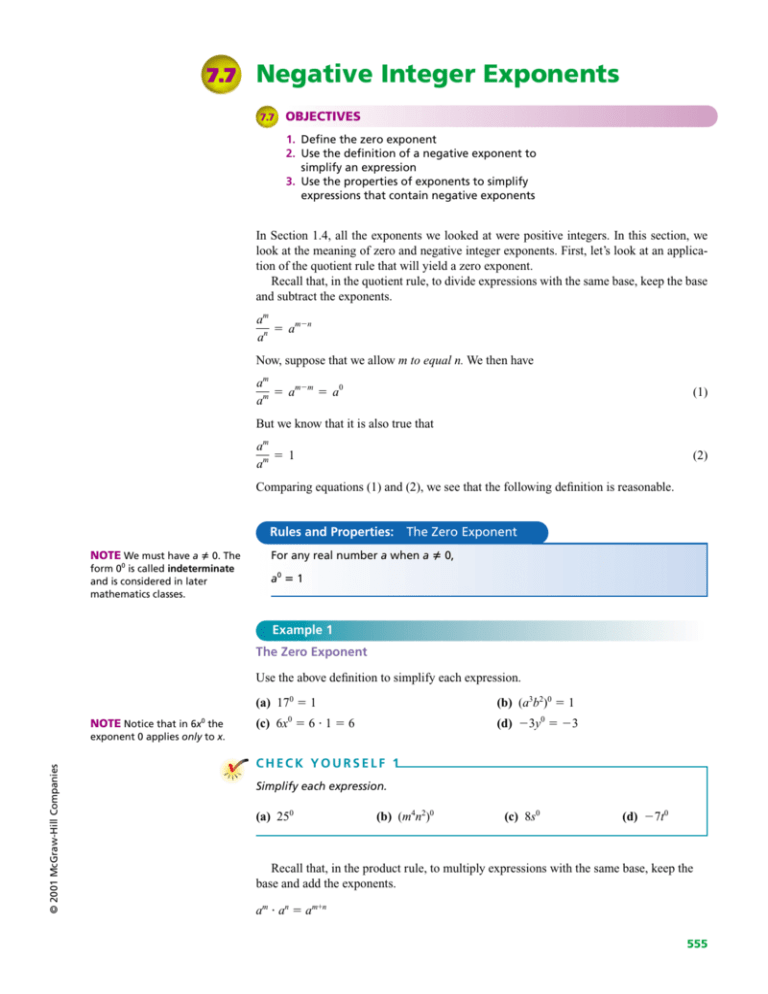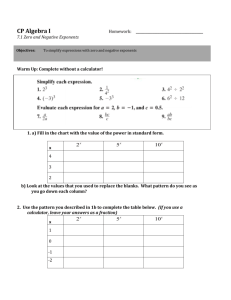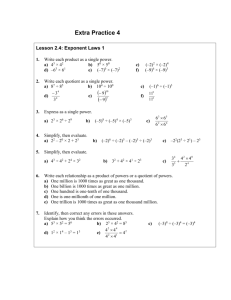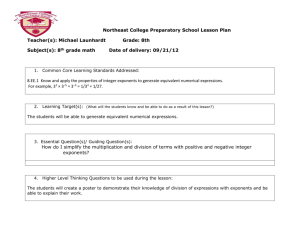Negative Integer Exponents
advertisement

7.7 Negative Integer Exponents 7.7 OBJECTIVES 1. Define the zero exponent 2. Use the definition of a negative exponent to simplify an expression 3. Use the properties of exponents to simplify expressions that contain negative exponents In Section 1.4, all the exponents we looked at were positive integers. In this section, we look at the meaning of zero and negative integer exponents. First, let’s look at an application of the quotient rule that will yield a zero exponent. Recall that, in the quotient rule, to divide expressions with the same base, keep the base and subtract the exponents. am amn an Now, suppose that we allow m to equal n. We then have am amm a0 am (1) But we know that it is also true that am 1 am (2) Comparing equations (1) and (2), we see that the following definition is reasonable. Rules and Properties: NOTE We must have a 0. The form 00 is called indeterminate and is considered in later mathematics classes. The Zero Exponent For any real number a when a 0, a0 1 Example 1 The Zero Exponent Use the above definition to simplify each expression. NOTE Notice that in 6x0 the (a) 170 1 (b) (a3b2)0 1 (c) 6x0 6 1 6 (d) 3y0 3 © 2001 McGraw-Hill Companies exponent 0 applies only to x. CHECK YOURSELF 1 Simplify each expression. (a) 250 (b) (m4n2)0 (c) 8s0 (d) 7t0 Recall that, in the product rule, to multiply expressions with the same base, keep the base and add the exponents. am an am+n 555 556 CHAPTER 7 RATIONAL EXPRESSIONS AND FUNCTIONS Now, what if we allow one of the exponents to be negative and apply the product rule? Suppose, for instance, that m 3 and n 3. Then am an a3 a3 a3(3) a0 1 so a3 a3 1 Dividing both sides by a3, we get a3 1 a3 Rules and Properties: Negative Integer Exponents NOTE John Wallis (1616–1702), For any nonzero real number a and whole number n, an English mathematician, was the first to fully discuss the meaning of 0, negative, and rational exponents. an 1 an and an is the multiplicative inverse of an. Example 2 illustrates this definition. Example 2 Using Properties of Exponents NOTE From this point on, to Simplify the following expressions. simplify will mean to write the expression with positive exponents only. (a) y5 1 y5 (b) 42 1 1 42 16 variables so that they represent nonzero real numbers. (c) (3)3 (d) 2 3 3 1 1 1 3 (3) 27 27 1 2 3 3 1 27 8 8 27 CHECK YOURSELF 2 Simplify each of the following expressions. (a) a10 (b) 24 (c) (4)2 (d) 5 2 2 © 2001 McGraw-Hill Companies NOTE Also, we will restrict all NEGATIVE INTEGER EXPONENTS SECTION 7.7 557 Example 3 illustrates the case in which coefficients are involved in an expression with negative exponents. As will be clear, some caution must be used. Example 3 Using Properties of Exponents Simplify each of the following expressions. CAUTION The expressions 4w2 and (4w)2 are not the same. Do you see why? (a) 2x3 2 1 2 3 3 x x The exponent 3 applies only to the variable x, and not to the coefficient 2. (b) 4w2 4 (c) (4w)2 1 4 2 w w2 1 1 (4w)2 16w2 CHECK YOURSELF 3 Simplify each of the following expressions. (a) 3w4 (b) 10x5 (c) (2y)4 (d) 5t2 Suppose that a variable with a negative exponent appears in the denominator of an expression. Our previous definition can be used to write a complex fraction that can then be simplified. For instance, 1 1 a2 a2 1 a2 1 1 a2 Negative exponent in denominator. Positive exponent in numerator. To divide, we invert and multiply. © 2001 McGraw-Hill Companies To avoid the intermediate steps, we can write that, in general, Rules and Properties: Negative Exponents in a Denominator For any nonzero real number a and integer n, 1 an an 558 CHAPTER 7 RATIONAL EXPRESSIONS AND FUNCTIONS Example 4 Using Properties of Exponents Simplify each of the following expressions. (a) 1 y3 y3 (b) 1 25 32 25 (c) 3 3x2 4x2 4 (d) b4 a3 b4 a3 The exponent 2 applies only to x, not to 4. CHECK YOURSELF 4 Simplify each of the following expressions. (a) NOTE To review these properties, return to Section 1.4. 1 x4 (b) 1 33 (c) 2 3a2 (d) c5 d 7 The product and quotient rules for exponents apply to expressions that involve any integer exponent—positive, negative, or 0. Example 5 illustrates this concept. Example 5 Using Properties of Exponents Simplify each of the following expressions, and write the result, using positive exponents only. x4 (b) m5 m5(3) m53 m3 m2 (c) NOTE Notice that m5 in the numerator becomes m5 in the denominator, and m3 in the denominator becomes m3 in the numerator. We then simplify as before. 1 x4 Add the exponents by the product rule. Subtract the exponents by the quotient rule. 1 m2 x5 (3) x2 x5x3 x2 (7) x9 x7 x7 x7 We apply first the product rule and then the quotient rule. In simplifying expressions involving negative exponents, there are often alternate approaches. For instance, in Example 5(b), we could have made use of our earlier work to write m3 1 m5 m35 m2 2 3 m m5 m © 2001 McGraw-Hill Companies (a) x3 x7 x3(7) NEGATIVE INTEGER EXPONENTS SECTION 7.7 559 CHECK YOURSELF 5 Simplify each of the following expressions. (a) x9 x5 (b) y7 y3 (c) a3a2 a5 The properties of exponents can be extended to include negative exponents. One of these properties, the quotient-power rule, is particularly useful when rational expressions are raised to a negative power. Let’s look at the rule and apply it to negative exponents. Rules and Properties: b a n a , b0 bn Rules and Properties: b a Quotient-Power Rule n n n n a b b n bn a a Raising Quotients to a Negative Power n a 0, b 0 Example 6 Extending the Properties of Exponents Simplify each expression. s3 t2 2 (a) (b) m2 n2 3 t2 s3 2 n2 m2 t4 s6 3 n6 1 6 6 6 m nm CHECK YOURSELF 6 Simplify each expression. (a) s3 3t 2 3 (b) x5 y2 3 As you might expect, more complicated expressions require the use of more than one of the properties for simplification. Example 7 illustrates such cases. © 2001 McGraw-Hill Companies Example 7 Using Properties of Exponents Simplify each of the following expressions. (a) (a2)3(a3)4 a6 a12 (a3)3 a9 a612 a6 a9 a9 a6(9) a69 a15 Apply the power rule to each factor. Apply the product rule. Apply the quotient rule. CHAPTER 7 RATIONAL EXPRESSIONS AND FUNCTIONS NOTE It may help to separate (b) the problem into three fractions, one for the coefficients and one for each of the variables. (c) 8x2y5 8 x2 y5 12x4y3 12 x4 y3 2 2(4) 53 x y 3 2 2 8 2x2 x y 8 3 3y pr3s5 p3r3s2 2 p3r3s2 pr3s5 p6r6s4 p2r6s10 2 p4r12s6 CAUTION p4s6 r12 Be Careful! Another possible first step (and generally an efficient one) is to rewrite an expression by using our earlier definitions. an 1 an and 1 an an For instance, in Example 8(b), we would correctly write 8x2y5 8x4 12x4y3 12x2y3y5 A common error is to write 12x4 8x2y5 12x4y3 8x2y3y5 This is not correct. The coefficients should not be moved along with the factors in x. Keep in mind that the negative exponents apply only to the variables. The coefficients remain where they were in the original expression when the expression is rewritten by using this approach. CHECK YOURSELF 7 Simplify each of the following expressions. (a) (x5)2(x2)3 (x4)3 (b) 12a3b2 16a2b3 (c) xy3z5 x4y2z3 CHECK YOURSELF ANSWERS 1 1 1 4 ; (c) ; (d) 10 ; (b) a 16 16 25 2 3 10 1 5 2a d7 4 ; (b) 27; (c) ; (d) 3. (a) 4 ; (b) 5 ; (c) ; (d) 4. (a) x w x 16y4 t2 3 c5 6 1 27t 1 3 y3z24 5. (a) x4; (b) 4 ; (c) a4 6. (a) 9 ; (b) 15 6 7. (a) x8; (b) ; (c) y s x y 4ab5 x15 1. (a) 1; (b) 1; (c) 8; (d) 7 2. (a) 3 © 2001 McGraw-Hill Companies 560 Name Exercises 7.7 Section Date In exercises 1 to 22, simplify each expression. 1. x5 2. 33 ANSWERS 3. 52 4. x8 5. (5)2 6. (3)3 7. (2)3 8. (2)4 9. 10. 3 4 2 11. 3x2 13. 5x4 14. (2x)4 16. 5x2 17. 19. 2 5x3 20. 2 3 3 12. 4x3 1. 2. 3. 4. 5. 6. 7. 8. 9. 10. 11. 12. 13. 14. 15. 16. 17. 18. 19. 20. 21. 22. 23. 24. 25. 26. 27. 28. 29. 30. 31. 32. 15. (3x)2 1 x3 18. 3 4x4 21. 1 x5 x3 y4 5 22. x y3 In exercises 23 to 32, use the properties of exponents to simplify the expressions. © 2001 McGraw-Hill Companies 23. x5 x3 24. y4 y5 25. a9 a6 26. w5 w3 27. z2 z8 28. b7 b1 29. a5 a5 30. x4 x4 31. 32. x5 x2 x3 x6 561 ANSWERS 33. 34. 35. 36. 37. 38. 39. 40. 41. 42. In exercises 33 to 58, use the properties of exponents to simplify the following. 33. (x5)3 34. (w4)6 35. (2x3)(x2)4 36. (p4)(3p3)2 37. (3a4)(a3)(a2) 38. (5y2)(2y)(y5) 39. (x4y)(x2)3(y3)0 40. (r4)2(r2s)(s3)2 41. (ab2c)(a4)4(b2)3(c3)4 42. (p2qr2)(p2)(q3)2(r2)0 43. (x5)3 44. (x2)3 45. (b4)2 46. (a0b4)3 47. (x5y3)2 48. (p3q2)2 49. (x4y2)3 50. (3x2y2)3 51. (2x3y0)5 52. a6 b4 53. x2 y4 x3 y2 55. x4 y2 56. (3x4)2(2x2) x6 44. 43. 45. 46. 47. 48. 49. 50. 51. 52. 54. 53. 55. 56. 57. 58. 59. 60. 61. 62. 63. 64. 65. 66. 54. 3 57. (4x2)2(3x4) 67. 58. (5x4)4(2x3)5 562 59. (2x5)4(x3)2 60. (3x2)3(x2)4(x2) 61. (2x3)3(3x3)2 62. (x2y3)4(xy3)0 63. (xy5z)4(xyz2)8(x6yz)5 64. (x2y2z2)0(xy2z)2(x3yz2) 65. (3x2)(5x2)2 66. (2a3)2(a0)5 67. (2w3)4(3w5)2 © 2001 McGraw-Hill Companies In exercises 59 to 90, simplify each expression. ANSWERS 3 2 3x6 y5 69. 2y9 x3 4 5 68. (3x ) (2x ) 2 5 6 4 71. (7x y)(3x y ) 74. (5a2b4)(2a5b0) 77. 80. 15x3y2z4 20x4y3z2 xy3z4 x y z 3 2 2 72. 75. 78. 2 81. 2w5z3 3x3y9 68. x8 2y9 70. 6 3 y x x5y4 w4z0 (x3)(y2) y3 24x5y3z2 36x2y3z2 x2y2 x4y2 x3y2 x2y2 69. 70. 2 2 3 4 2 73. (2x y )(3x y ) 71. 76. 79. 82. 6x3y4 24x2y2 x5y7 x0y4 x3y3 x4y2 3 x2y2 xy4 72. 73. 74. 75. 76. 77. 78. 79. 80. 81. 1 82. n3 83. x2n x3n 84. xn1 x3n 85. x xn1 83. 84. 86. xn4 xn1 87. (y n)3n 88. (xn1)n 85. 86. 89. x2n xn2 x3n 90. xn x3n5 x4n 87. 88. 91. Can (a b)1 be written as not? Explain. 1 1 by using the properties of exponents? If not, why a b 92. Write a short description of the difference between (4)3, 43, (4)3, and 43. 89. 90. 91. Are any of these equal? © 2001 McGraw-Hill Companies 92. 93. If n 0, which of the following expressions are negative? (n)3, n3, n3, (n)3, (n)3, n3 93. If n 0, which of these expressions are negative? Explain what effect a negative in the exponent has on the sign of the result when an exponential expression is simplified. 563 Answers 1. 15. 1 x5 3. 1 9x2 1 25 17. x3 29. 1 33. x15 31. y4 x2 65. 75x2 y5 x3 2 87. y3n 1 x3 43. 55. 7. 2x3 5 y2 x4 48 x8 67. 144w2 3xy5 4z6 89. x2 77. 69. 79. 91. 27 8 y4 x3 11. 23. x2 3 x2 13. 25. 1 a3 5 x4 27. 1 z10 39. x10y 45. b8 57. 9. 21. 37. 3a 1 x15 1 8 x10 y6 47. 59. 16x26 3x3 2y4 1 5 3 xy 49. x12y6 61. 72 x3 71. 567x22y25 81. y8 x7 83. x5n 51. x15 32 63. x42y33z25 73. 6 x2y5 85. x2 93. © 2001 McGraw-Hill Companies 75. 19. 35. 2x5 41. a17b8c13 53. 1 25 5. 564






